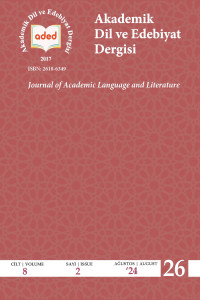Abstract
Tokadî-zâde Şekîb, XX. yüzyıl klasik Türk edebiyatı geleneğini devam ettiren şahsiyetlerden biridir. Birçok eser kaleme alan Şekîb’in bu eserlerinden biri de manzum ve mensur metinler içeren Neşîde-i Vicdân’dır. Neşîde-i Vicdân’ın manzum kısmında gazel, kaside, mesnevi, terkib-bend, kıta ve murabba nazım şekilleri ile yazılmış şiirler yer almaktadır. Şair, eserine bir kaside ile başlamış, bir kıta ile eserini sonlandırmıştır. Hz. Muhammed’e ve Ehl-i beyt’e dair derin bir muhabbetin gözlemlendiği şiirlerin bir kısmını dinî ve tasavvufi bağlamda değerlendirmek mümkündür. Özellikle naatlarda ve mersiyelerde bu hususun öne çıktığı, akıcı ve coşkun bir ruh hâlinin dikkat çektiği görülür. Aruz kusurlarına pek rastlanmayan şiirlerde Arapça ve özellikle Farsça terkipler yoğun olarak kullanılmıştır. Ayrıca manzumelerde mürdef kafiye fazlaca kullanılmıştır.
Bu çalışmada hacminden dolayı mensur metinler kapsam dışında tutulmuş, sadece manzum metinler üzerinde durulmuştur. Bu çerçevede önce şairin hayatı hakkında kısa bir bilgi verilmiş, sonra manzumelerin çeviri yazısı yapılarak manzumelerin yapı ve anlam özelliklerine yer verilmiştir. Çalışmanın sonuna ise eserin manzum bölümlerinin orijinal metni eklenmiştir.
References
- Çağın, S. (1998). Tokadîzade Şekip. Akademi Kitabevi.
- Çağın, S. (2021). Şekip (Tokadîzade). Türk Edebiyatı İsimler Sözlüğü. https://teis.yesevi.edu.tr/madde-detay/sekip-tokadizade, [E.T. 02.04.2024].
- Devellioğlu, F. (2011). Osmanlıca-Türkçe Ansiklopedik Lûgat. Aydın Kitabevi Yayınları.
- Dilçin, C. 2018). Yeni Tarama Sözlüğü. TDK Yayınları.
- Kaçar, M. (2015). Klasik Türk Edebiyatında Kafiye. Ö. Şenödeyici (Ed.), Osmanlı Edebî Metinlerini Anlama Kılavuzu içinde (s. 37-54). Kesit Yayınları.
- Kanar, M. (2014). Farsça-Türkçe Türkçe-Farsça Sözlük. Say Yayınları.
- Karahan, T. (2020). Tokadîzâde Şekip Bey’in Derviş Sözleri Adlı Eseri. Akademik Dil ve Edebiyat Dergisi. 4(1), 27-58.
- Tokadîzâde Şekib. (1325/1909). Neşîde-i Vicdân. İstanbul Büyükşehir Belediyesi Atatürk Kitaplığı, Bel_Osm_K.06213.
- Uçman, A. (2012). Tokadîzâde Şekib Bey. TDV İslam Ansiklopedisi (C. 41, s. 216-217). İstanbul: TDV Yayınları. Kubbealtı Lugatı, http://lugatim.com/ [E.T. 26.03.2024].
- Türk Dil Kurumu Sözlükleri, https://sozluk.gov.tr/
Abstract
Tokadî-zâde Şekîb is one of the figures who continue the tradition of 20th century classical Turkish literature. One of the works of Şekîb, who has written many works, is Neşîde-i Vicdân, which contains texts in verse and prose. The verse part of Neşîde-i Vicdân includes poems written in ghazal, ode, masnavi, terkib-bend, stanza and murabba verse forms. The poet began his work with an ode and ended it with a stanza. It is possible to evaluate some of the poems in which a deep love for the Prophet Muhammad and the Ahl al-Bayt is observed in a religious and mystical context. It is seen that this aspect comes to the fore especially in naats and elegies, and a fluent and enthusiastic mood attracts attention. Arabic and especially Persian phrases were used extensively in the poems, in which aruz defects were rarely encountered. In addition, mürdef rhyme is used extensively in the poem.
In this study, prose texts were excluded from the scope due to their volume, and only verse texts were focused on. In this context, first, brief information about the poet's life is given, then the verses are transcribed and the structural and semantic features of the verses are included. At the end of the study, the original text of the poetic sections of the work has been added.
References
- Çağın, S. (1998). Tokadîzade Şekip. Akademi Kitabevi.
- Çağın, S. (2021). Şekip (Tokadîzade). Türk Edebiyatı İsimler Sözlüğü. https://teis.yesevi.edu.tr/madde-detay/sekip-tokadizade, [E.T. 02.04.2024].
- Devellioğlu, F. (2011). Osmanlıca-Türkçe Ansiklopedik Lûgat. Aydın Kitabevi Yayınları.
- Dilçin, C. 2018). Yeni Tarama Sözlüğü. TDK Yayınları.
- Kaçar, M. (2015). Klasik Türk Edebiyatında Kafiye. Ö. Şenödeyici (Ed.), Osmanlı Edebî Metinlerini Anlama Kılavuzu içinde (s. 37-54). Kesit Yayınları.
- Kanar, M. (2014). Farsça-Türkçe Türkçe-Farsça Sözlük. Say Yayınları.
- Karahan, T. (2020). Tokadîzâde Şekip Bey’in Derviş Sözleri Adlı Eseri. Akademik Dil ve Edebiyat Dergisi. 4(1), 27-58.
- Tokadîzâde Şekib. (1325/1909). Neşîde-i Vicdân. İstanbul Büyükşehir Belediyesi Atatürk Kitaplığı, Bel_Osm_K.06213.
- Uçman, A. (2012). Tokadîzâde Şekib Bey. TDV İslam Ansiklopedisi (C. 41, s. 216-217). İstanbul: TDV Yayınları. Kubbealtı Lugatı, http://lugatim.com/ [E.T. 26.03.2024].
- Türk Dil Kurumu Sözlükleri, https://sozluk.gov.tr/
Details
| Primary Language | Turkish |
|---|---|
| Subjects | Classical Turkish Literature of Ottoman Field |
| Journal Section | Articles |
| Authors | |
| Publication Date | August 30, 2024 |
| Submission Date | June 15, 2024 |
| Acceptance Date | August 17, 2024 |
| Published in Issue | Year 2024 Volume: 8 Issue: 2 |
This work is licensed under Attribution-NonCommercial 4.0 International


